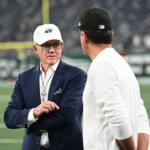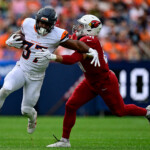The quickest way for the Giants to climb out of quarterback hell is also the quickest way to extend their stay there for at least three more years.
Now that Daniel Jones has been benched for Tommy DeVito and his disappointing six-year tenure with the Giants is certain to be over by March, the internal search for the next franchise quarterback is accelerating. The Giants (2-8) already are careening toward a top-five draft pick, so that part of the equation is in place.
There’s only one big problem: The 2025 quarterback draft class is considered weak by the last decade’s standard, especially compared to its historically well-regarded 2024 predecessor.
Should the Giants spend a high first-round pick on Jones’ replacement anyway? Or is that a recipe for disaster?
“Isn’t that how they got in this situation in the first place?” one NFL scout asked rhetorically, referring to the overdrafting of Jones with pick No. 6 in 2019, as Eli Manning neared retirement and coveted prospect Justin Herbert went back to school.
Nuance is needed to peel back the many layers of the Great Giants Quarterback Debate commanding fans’ attention: How high is their draft pick? How many quarterbacks are worthy of first-round picks? Who will be at the controls? Are draft projections often correct? What are the alternatives? Can they afford to punt on another season by pushing off the quarterback pick until the 2026 draft?
But the biggest issue of all remains whether it is worth the risk to force drafting a quarterback to fill a need. Why not reach as a bet on potential when hitting on those picks already feels like a crapshoot?
“Need drives the quarterback market because people aren’t disciplined,” one NFL executive said. “Patience comes when you have options. What happens is teams have no options when they get to the draft, so they start throwing darts. You have to solve the problem, but you don’t have to take a swing on something you are not convicted on.”
ESPN draft analyst Matt Miller has first-round grades on just two quarterbacks likely to enter the draft: Colorado’s Shedeur Sanders and Miami’s Cam Ward, both of whom he expects to be top-10 picks. That’s not great with nine current two- or three-win teams, including six that could be looking to change quarterbacks in the offseason.
What’s more discouraging?
Miller says both Sanders and his “surgical” accuracy as well as Ward and his “ability to dial up velocity like crazy” fall lower than the top-four quarterbacks that he graded in last year’s class — Caleb Williams, Jayden Daniels, Drake Make and J.J. McCarthy — and comparably to his No. 5 and No. 6 options (Michael Penix Jr. and Bo Nix).
“When you are 30 years old and realize all your friends are married and having kids, you start to feel the pressure a little bit. Like, ‘I should probably find someone,’” Miller said. “That’s how QBs get elevated every year. Someone is going to make a jump and then try to justify it after the fact instead of just falling in love with the actual player.”
Will it be the Giants? Raiders? Titans?
The Giants tried and failed to trade from No. 6 to No. 3 to draft Daniels or Maye but passed on McCarthy, Penix Jr. and Nix. One year later, they are currently slated to select No. 4 — and have a 21 percent chance to land No. 1, per ESPN analytics — but that will change over the next seven weeks against the 13th-most-difficult remaining schedule.
How does anyone in Giants general manager Joe Schoen’s shoes tell the difference between true love and forced love when facing a once-in-a-career opportunity?
“You want to stick to your board,” said former Jets general manager Mike Tannenbaum, founder of The 33rd Team think tank. “The more you can be process-driven, the better chance you have of getting more decisions right than wrong. Time shows drafting for need is where mistakes are made.”
Who’s the boss?
Time is not infinite in the NFL.
If Schoen and head coach Brian Daboll are retained, they will be entering Year 4 and taking their second shot at identifying a franchise quarterback, after inking Jones to a four-year, $160 million extension that failed miserably.
Hot seats might lead them to favor signing a win-now veteran.
Or the pressure could drive them to overdraft a prospect knowing that a proper developmental timeline should extend their clocks through the 2026 season because it is a bad idea to make sweeping changes after a quarterback’s rookie season — as the Giants did with Jones.
“You need to make a two-year commitment,” a second NFL executive said. “Because the next coach and GM might not agree with the quarterback you drafted and then you are limiting your search.”
A new regime with a bigger runway might take a more honest look at the 2025 class. But John Mara originally hired Schoen and Daboll in part because of their experience drafting and developing Josh Allen to the Bills after six teams (including the Giants) passed in 2018.
“You can force a quarterback if he has rare physical and athletic ability,” a second scout said. “You don’t want to take just any quarterback, though. You want the right quarterback you have a vision for.”
Quarterback evaluations in 2025 will be made against the backdrop of shorter-than-ever leashes on top picks. The Panthers’ Bryce Young and Colts’ Anthony Richardson — the No. 1 and No. 4 picks, respectively, in 2023 — were benched as second-year pros.
In between those two potential busts, C.J. Stroud was a franchise-changer for the Texans. The feeling inside the Giants is that they are a Stroud or a Daniels — both rookie sensations — away from the playoffs.
“There are all these different factors that present chaos when making these decisions,” said NFL Network analyst Marc Ross, the former scouting director for the Giants and Eagles. “What if your owner is putting pressure on that you have to pick one? Or what if you’re a GM in his last year?
“If I’m a lame duck, I’m going to take a swing. Because if I’m trotting out a 40-year-old, I know what I’m getting and I’m not going to be here next year. If you have job security and freedom, you can say, ‘I am making moves because this is the way we are evaluating talent,’ as opposed to being in desperation mode all the time.”
Complicating factors
A running joke since Manning retired is that one day his nephew, five-star recruit Arch, would quarterback the Giants.
Well, Arch will finally be draft-eligible in 2026, though he is not yet even starting full-time at Texas. LSU’s Garrett Nussmeier and Penn State’s Drew Allar — both draft-eligible in 2025 but thought likely to return to school — and Tennessee’s Nico Iamaleava have created buzz in scouting circles, but there is no early consensus “can’t-miss” prospect in 2026.
Waiting longer than this April for the next beacon of hope while some stopgap replaces Jones is a big ask of frustrated Giants fans who have endured a 39-85-1 record since 2017. Only the Jets are worse, as two of their many busted draft picks — Sam Darnold (Vikings) and Geno Smith (Seahawks) — cause a rethinking of where to find answers.
“When teams say they want to find next year’s Sam Darnold, that situation exists but you have to be better at evaluating than others to find it,” the first executive said. “There’s some team who will turn to a $10 [million] or $15 million per year [quarterback] and they’ll succeed because of it until they get to the long-term answer.”
Tannenbaum once traded up to draft Mark Sanchez — a marriage of “like” and “need,” he said — and paired him with veteran Mark Brunell when Brett Favre retired from the Jets.
He pointed to three journeymen who were thought to be mere bridges but are all playing well for their fourth NFL teams — Smith, Darnold and Baker Mayfield (Buccaneers) — as need-fillers.
“The Giants need a quarterback to stabilize the position,” he said. “You can win for today, develop for tomorrow and draft somebody who may or may not be in the first round.
“Good organizations are prepared to take advantage of opportunities. I don’t think in this day and age you can not win for a couple years in a row and expect people to believe in what you are doing, so I think you have to balance long-term beliefs with short-term success. It’s a position where you have to exhaust all possible solutions.”
Three SEC quarterbacks — Georgia’s Carson Beck (uptick in interceptions), Texas’ Quinn Ewers (inconsistencies) and Alabama’s Jalen Milroe (raw passer) — have flaws that stick them in the second-round conversation, Miller said. Any could move up through the NFL Combine, college pro days and private meetings.
“It’s such a farce when quarterbacks get invented during everything after the season,” Ross said. “You better know right now when you are going to games that, ‘This is the guy.’ Everything else from there, you are validating. When you are talking yourself into someone, that’s when mistakes happen. At this time, we are talking about what’s seen as a weak class. Come March, everyone is going to be saying, ‘Well, this guy can be a franchise guy.’ ”
What’s ahead?
Hall of Fame executive Ron Wolf believed in drafting a quarterback — not necessarily a first-rounder — every year.
Go behind the scenes with Big Blue
Sign up for Inside the Giants by Paul Schwartz, a weekly Sports+ exclusive.
Thank you
Ross sees teams getting more “leeway to talk yourself into all of the upside and ignore all of the downside” nowadays.
Miller predicts that multiple years of college starting experience will have increased value to scouts in 2025, and that the price of trading up won’t be as steep as normal without a “golden goose.”
Quarterback classes rarely work out as projected. Since the historic 2020 class that produced five quarterbacks in the first 53 picks who later signed $50-plus-million-per-year extensions:
— 2021: Four of the five first-rounders are on their second teams.
— 2022: The only starter of the nine quarterbacks drafted is the last one (49ers’ Brock Purdy, pick No. 262).
— 2023: Young and Richardson are headed in very different directions than Stroud.
— 2024: The sixth quarterback and No. 12 overall pick in 2024 (Nix) is outplaying the No. 1 pick (Williams).
For the Giants, the process is even more complicated.
“The intangibles, the personality might matter more in New York than anywhere else,” the first executive said. “Not everyone can handle that.”
But the search is underway.








